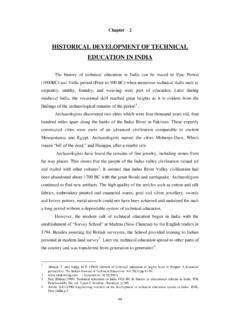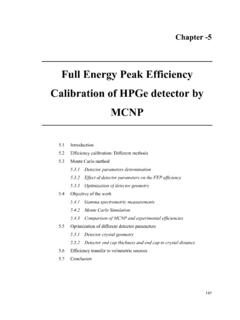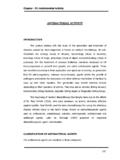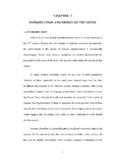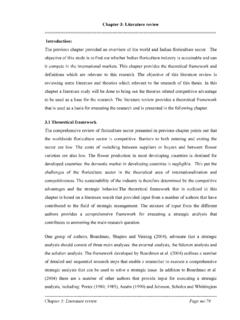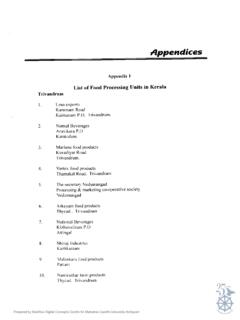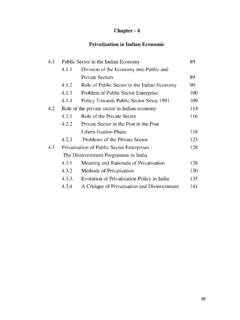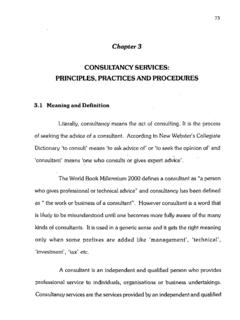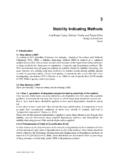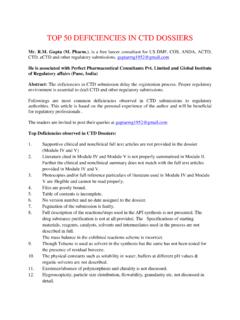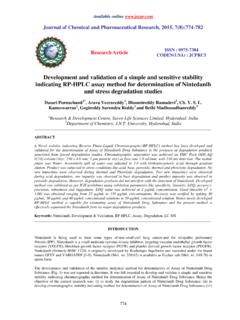Transcription of Chapter-2 Analytical Method Development and …
1 Chapter-2 . Analytical Method Development and validation Overview The primary focus of this chapter is on general approaches and considerations toward Development of chromatographic methods for separation, identification, and quantification of pharmaceutical compounds, which may be applied within the various functions in the drug Development continuum. The chapter also discusses the issues and parameters that must be considered in the validation of Analytical methods . At the end of the chapter , a scope of the present research study is covered. GENERAL INTRODUCTION. The number of drugs introduced into the market is increasing every year. These drugs may be either new entities or partial structural modification of the existing one. Very often there is a time lag from the date of introduction of a drug into the market to the date of its inclusion in pharmacopoeias. This happens because of the possible uncertainties in the continuous and wider usage of these drugs, reports of new toxicities (resulting in their withdrawal from the market), Development of patient resistance and introduction of better drugs by competitors.
2 Under these conditions, standards and Analytical procedures for these drugs may not be available in the pharmacopoeias. There is a scope, therefore to develop newer Analytical methods for such drugs. Analytical methods Development and validation play important roles in the discovery, Development , and manufacture of pharmaceuticals. Pharmaceutical products formulated with more than one drug, typically referred to as combination products, are intended to meet previously unmet patients need 55. Analytical Method Development and validation by combining the therapeutic effects of two or more drugs in one product. These combination products can present daunting challenges to the Analytical chemist responsible for the Development and validation of Analytical methods . The official test methods that result from these processes are used by quality control laboratories to ensure the identity, purity, potency, and performance of drug products.
3 Identification and quantification of impurities is a crucial task in pharmaceutical process Development for quality and safety. Related components are the impurities in pharmaceuticals which are unwanted chemicals that remain with the active pharmaceutical ingredients (APIs), or develop during stability testing, or develop during formulation or upon aging of both API and formulated APIs to medicines. The presence of these unwanted chemicals even in small amounts may influence the efficacy and safety of the pharmaceutical products. Various Analytical methodologies are employed for the determination of related components in pharmaceuticals. There is a great need for Development of new Analytical methods for quality evaluation of new emerging drugs. Basic criteria for new Method Development of drug analysis: The drug or drug combination may not be official in any pharmacopoeias, A proper Analytical procedure for the drug may not be available in the literature due to patent regulations, Analytical methods may not be available for the drug in the form of a formulation due to the interference caused by the formulation excipients, Analytical methods for the quantitation of the drug in biological fluids may not be available, Analytical methods for a drug in combination with other drugs may not be available, The existing Analytical procedures may require expensive reagents and solvents.
4 It may also involve cumbersome extraction and separation procedures and these may not be reliable. 56. Chapter-2 . Method validation The need to validate an Analytical or bioanalytical Method is encountered by analysis in the pharmaceutical industry on an almost daily basis, because adequately validated methods are a necessity for approvable regulatory filings. What constitutes a validated Method , however, is subject to analyst interpretation because there is no universally accepted industry practice for assay validation . Literature survey When develop an HPLC/UPLC Method , the first step is always to consult the chromatographic literature to find out if anyone else has done the analysis, and how they did it. This will at least give an idea of the conditions that are needed, and may save one having to do a great deal of experimental work. PHARMACEUTICAL IMPURITIES. An impurity in a drug substance as defined by the International Conference on Harmonisation (ICH) Guidelines [1] is any component of the drug substance that is not the chemical entity defined as the drug substance.
5 Similarly, an impurity in a drug product is any component of the drug product that is not the chemical entity defined as the drug substance or an excipient in the drug product [2]. The safety of a drug product is dependent not only on the toxicological properties of the active drug substance itself, but also on the impurities that it contains. Therefore, identification, quantification, and control of impurities in the drug substance and drug product, are an important part of drug Development and regulatory assessment. ICH Q3A and Q3B address issues relevant to the regulation of impurities in the drug substance and drug product. While many of the concepts and principles outlined in these documents are applicable to Abbreviated New Drug Applications (ANDAs), certain additional or modified restraints need to be considered. When FDA receives an ANDA, a monograph defining certain key attributes of the drug substance and drug product is frequently available in the United States Pharmacopeia (USP).
6 Sometimes, literature information on 57. Analytical Method Development and validation drug product impurities may also be available. These public standards and literature data play a significant role in the regulatory assessment process of an ANDA. Classification of impurities The safety and quality of the drug substance and drug product in a generic product can be impacted by the presence of impurities. The nature and the quantity of these impurities is governed by a number of factors, including synthetic route of the drug substance, reaction conditions, quality of the starting material of the drug substance, reagents, solvents, purification steps, excipients, drug product manufacturing processes, packaging, and storage of the end product. Based on ICH Q3A. [1], drug substance impurities can be classified into the following categories: Organic impurities (process- and drug-related).
7 Inorganic impurities Residual solvents Organic impurities can arise during the manufacturing process and/or storage of the drug substance. They can be identified or unidentified, volatile or non-volatile, and include: Starting materials By-products Intermediates Degradation products Reagents, ligands, and catalysts Inorganic impurities can result from the manufacturing process. They are normally known and identified and include: Reagents, ligands and catalysts Heavy metals or other residual metals Inorganic salts Other materials ( , filter aids, charcoal). 58. Chapter-2 . Solvents are inorganic or organic liquids used as vehicles for the preparation of solutions or suspensions in the synthesis of the drug substance or the manufacture of the drug product. Since these are generally of known toxicity, the selection of appropriate limits for these solvents is easily accomplished (ICH Q3C [3] on residual solvents).
8 Control of impurities A specification is defined as a list of tests, references to Analytical procedures, and appropriate acceptance criteria that are numerical limits, ranges, or other criteria for the tests described [4]. It establishes the set of criteria to which a drug substance or drug product should conform to be considered acceptable for its intended use. Conformance to specifications means that the drug substance and/or drug product, when tested according to the listed Analytical procedures, will meet the listed acceptance criteria [5]. Specifications are critical quality standards that are proposed and justified by the manufacturer and approved by regulatory authorities as conditions of approval. Listing of impurities in drug substance specification The specifications for a drug substance include a list of impurities. Stability studies, chemical Development studies, routine batch analyses, and scientific appraisal of potential by- products from synthetic steps and degradation pathways, can be used to predict those impurities likely to occur in the drug substance.
9 The drug substance specification includes, where applicable, a list of the following types of impurities: Organic impurities Each identified specified impurity Each specified unidentified impurity Any unspecified impurity with an acceptance criterion of not more than ( ) in the identification threshold in Table Total impurities Residual solvents Inorganic impurities 59. Analytical Method Development and validation Table Drug substances impurities thresholds Maximum Reporting Identification threshold c Quantification threshold c daily dose a threshold b c % or mg/day % or mg/day intake < 2 g/day %. intake (whichever is less) (whichever is less). > 2 g/day % % %. a The amount of drug substance administered per day. b Higher reporting threshold should be scientifically justified. c Lower threshold can be appropriate if the impurities are unusually toxic. Listing of impurities in drug product specification The specification for a drug product should include a list of degradation products.
10 Stability studies, chemical Development studies, and routine batch analyses can be used to predict the degradation profile for the commercial product. The drug product specification includes, where applicable, types of degradation products are: Each specified identified degradation product Each specified unidentified degradation product Any unspecified degradation product with an acceptance criterion of not more than ( ). the identification threshold in [Figure ]. Total degradation products Based on the maximum daily dose, impurities in new drug products should be controlled as shown in the Figure [Figure ICH Q3B(R) Drug products impurity thresholds]. 60. Chapter-2 . REGULATORY STATUS OF STABILITY-INDICATING ASSAYS. The ICH guidelines have been incorporated as law in the EU, Japan and in the US, but in reality, besides these other countries are also using them. As these guidelines reflect the current inspectional tendencies, they carry the de facto force of regulation.
